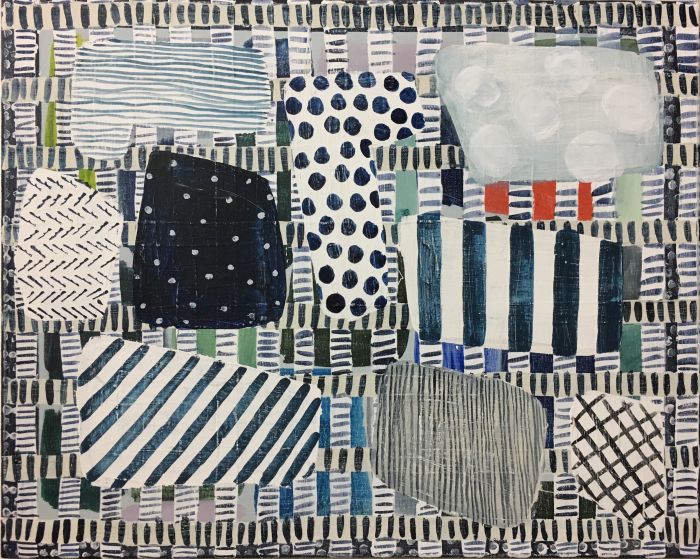Julia Flanagan is primarily a painter with a growing interest in sculpture. Born in Newcastle, Julia moved to Sydney to study painting and completed her Bachelor of Fine Arts at the National Art School in 2004 and her Painting Honours in 2005.
It seems like one work generates the next …
I like to work on multiple pieces at the same time and usually begin priming and stretching canvases as I’m finishing off others. This means I always have something to work on. I also find it helps me think about what needs to be done to the works in progress. I like to rotate the finished works on my studio wall, which I look at constantly for ideas for the next lot of work. The shapes within my drawings and constructions are also a source of material for my paintings.
The works are quite whimsical.
I seek to create pieces that are whimsical, quirky and joyful. I admire the playfulness in children’s art making and have been inspired by my children’s lack of inhibitions when it comes to painting or drawing. They just jump in and make what comes to mind. I think my work has a certain naivety, though I guess it’s coming from an understanding about composition and colour theory, at least a little.
Can you share a little about your art practice.
I’m fortunate to have my studio at home, a small shed in my backyard. It’s a great little space which opens up to the yard. It’s quiet mostly, with just the neighbourhood sounds and birds. When the weather is nice I can have the big doors open which provides really beautiful light and warmth. I’m fairly regimented in my studio routine. I like to spend Monday to Friday on my art practice. I have two school-aged kids, so my time is limited to when they are at school. As soon as they’re off to school, I eat, have coffee then head out to the studio.
I really enjoy working across a range of mediums, though I would say I’m primarily a painter. I have recently started making timber constructions, which has evolved from a series of small playful oil pastel drawings. I have also switched to working in acrylic paints in the last few years as it’s a little less toxic for my kids to be around. Not only that, the fast drying of acrylics suits my current painting process.
I work in a fairly improvised way and like to build up multiple layers quickly. Often my paintings begin with an initial idea for a first layer, then are developed from there. I use my library of patterns from my textiles and also make many quick oil pastel drawings. I draw on these for colour combinations and inspiration for compositions.
I seek to create a sense of perspective within the works, pathways through the layers of pattern and colour. I like that you can see little traces of what was there and painted out. The underneath layers add to the depth of the work. My timber constructions begin in a playful and freeform way, as I plan them out through quick oil pastel sketches. Unlike my paintings, I really need to work from my sketches to create the 3D forms rather than improvising along the way.
Is there a colour theory or tradition underlying your compositions?
Bauhaus artist Paul Klee is a constant source of inspiration. Not only did he produce incredible work, he was so prolific. If I were to say there was any colour theory underlying my work, it’s loosely related to his teachings. I’m interested in creating a sense of harmony within the colour arrangements, looking at how colours can relate to one another, vibrate and glow. More than anything I thrive on mixing colour and mucking around with different colour combinations. I’m inspired by many Australian artists such as Ildiko Kovacs, Idris Murphy and Minnie Pwerle. There’s also some amazing abstract artists from America – Keltie Ferris and Matt Kleberg to name a couple, and I love the work of Danish artist Tal R.
In what ways are you inspired by living and working in Sydney?
My everyday environment is always a source of inspiration. I enjoy walking along the streets in my neighbourhood looking at gardens, patterns within fences and local shopfront signage. I’ve always been fascinated with design and architecture and enjoy wandering through the city. There are some pretty amazing new buildings and beautiful old ornate ones sitting together in such a lovely kind of awkwardness. I’m constantly seeking out patterns within my suburban surrounds, from tiles to textiles and even graffiti scrawled along laneways.





